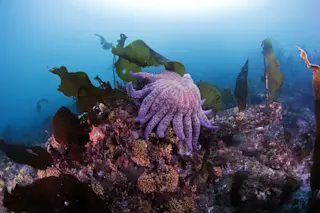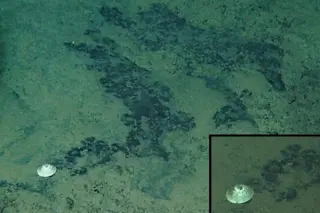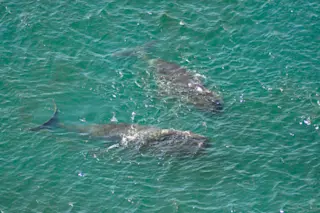Puntarenas, Costa Rica, is no tourist haven. Here you won’t find people peering through binoculars in hopes of spotting a toucan, or buses carrying visitors to the rain forest. Unlike much of the rest of the country, Puntarenas relies for its fortune not on genteel ecotourism but on the sea. Located on a spit of land jutting into the Gulf of Nicoya and out toward the Pacific, it’s a fishing town to its core, complete with bars on every corner, dogs wandering down pockmarked streets, and prostitutes doing their best to entice the men to spend their pay on something other than alcohol.
In a small shop on the main street, businessman Elicinio Briceño Ugalde proudly displays his own take from the sea. A cartoon shark grins from the labels of the blue-and-white bottles lined up on glass-topped counters. Shark cartilage pills, Briceño Ugalde says, smiling himself. Come into my office and I’ll show you what it’s all about. He ducks through a doorway and down a grimy hallway of tiny, padlocked hotel rooms-- his other business--and into the bar that doubles as his office. He turns down the jukebox and pops a videocassette into a player. A reporter on the screen begins detailing the new industry that is allowing Briceño Ugalde and many other people in Puntarenas to make a tidy living, at least by Costa Rican standards.
Shark cartilage, claims the reporter, can cure cancer.
The reporter, from a Mexican television station, goes on to state that several years ago, scientists at no less an institution than Harvard discovered that shark cartilage could cure up to 80 percent of cancer cases. Looking at X-rays of reportedly cured patients, he declares, The shark is no longer an animal to be feared. The shark now gives life.
Taking such reports to heart, Puntarenans like Briceño Ugalde have thrown their money and labor into the shark cartilage business, hauling thousands of the fish from the sea, stripping out the cartilage that makes up their skulls and spines, drying and pulverizing it, and slipping it into gelatin capsules for over-the-counter sale as food supplements. Briceño Ugalde claims his shark-grinding operation sells 10,000 bottles of pills each month, at about $8.50 for a bottle of sixty 300-milligram pills.
Briceño Ugalde may be exaggerating his sales figures. He and a few others supply only the local market. But a few miles up the Pan American Highway, an armed guard stands sentry at a complex of warehouses, the Corporacio´n Procesadora Cartílago. There thousands upon thousands of sharks are pulverized and readied for pill form. Those pills end up in American health food stores, under the brand name Cartilade, and sell for about $32 for ninety 740-milligram capsules.
Proponents of shark cartilage claim it can cure everything from arthritis to lupus to cancer. Especially cancer. In one of the biggest health fads since laetrile--the apricot-pit-based cure for cancer that was all the rage in the 1970s--shark cartilage pills are being snatched up by thousands of cancer patients. The therapy is riding on the coattails of an accepted medical premise: for a tumor to grow, it needs nourishment, so it must induce new blood vessels to grow toward it, in a process called angiogenesis. Theoretically, if that blood supply can be cut off, tumors will wither and die. Shark cartilage, its advocates swear, is anti- angiogenic: it can cut off the blood.
Researchers who conducted the angiogenesis studies being cited as proof for this therapy are furious. Yes, they say, there might well be something in shark cartilage, but it’s an awfully big leap from their laboratory studies to a cure for cancer. They find themselves misquoted and used as pawns in what many see as a scam. They fear that such misplaced interest in cartilage will detract from years of legitimate research into angiogenesis, which could indeed someday lead to new treatments for cancer. Environmentalists, too, are upset. Sharks worldwide have taken a beating lately, and this blossoming interest in shark cartilage could mean disaster.
The cartilage craze can be traced back to 1983, when I. William Lane, a nutritionist and biochemist from New Jersey, read a report on angiogenesis. I saw a paper in Science, says Lane, that said shark cartilage could inhibit new blood vessels and stop the growth of cancer. He got hold of some cartilage, spent three years processing it, and then tried to interest researchers in it. Everybody laughed at me, but I kept at it, he says. Eventually he convinced scientists at the Institut Jules Bordet in Brussels to take a look. According to Lane, their study showed that when shark cartilage was fed to mice with melanoma, tumors shrank by an average of 40 percent. In 1991, after having no luck in rousing the interest of the National Cancer Institute or other government agencies, Lane took his product to a controversial alternative cancer treatment center in Mexico. Eight terminally ill cancer patients were given daily enemas of a shark cartilage solution. Seven of the eight improved, says Lane, showing a 30 to 100 percent reduction in tumor size.
Lane’s next clinical trial brought him widespread attention as well as scorn. In 1992 he began working with doctors in Cuba, treating 29 terminally ill cancer patients. All of them were next to death, he recalls, but lo and behold, after six weeks they were starting to respond. Today, three and a half years later, he says, 14 of the patients are cancer-free, 9 have died of cancer, and 6 have died of other causes. The results were deemed dramatic enough to be featured on 60 Minutes in 1993. From then on, says Lane, I was famous. Worldwide sales of his book, Sharks Don’t Get Cancer, took off, and shark cartilage became a $50- million-a-year industry. According to various estimates, some 25,000 to 100,000 people are now using one of dozens of brands of shark cartilage, getting it in health food stores, from infomercials, and over the Internet. At least some of them are buying Benefin, the tins of powdered cartilage Lane’s son peddles out of Australia at about $130 a pound.
Lane contends that four proteins in shark cartilage are able to stop the growth of blood vessels. But when asked to explain exactly what these proteins are and how they work, he brushes off questions. Who cares how it works? What’s more important is, does it work? He then launches into a discussion of how cancer research moves too slowly. I’ve devoted my time to taking research to the people. When you’ve got a holocaust, you can’t afford to chew your cud. You’ve got to do something.
Most scientists, of course, care very much about how something works, and for all his impassioned rhetoric, Lane has had little luck convincing them of the value of his theories.
Carl Luer is a senior scientist at Mote Marine Laboratory in Sarasota, Florida, and one whose work Lane often cites. In the mid-1980s, Luer tried to induce tumors in sharks by exposing laboratory fish to carcinogens. No tumors ever formed, as Lane points out in his book. But, says Luer, though sharks tend not to get cancer, their cartilage probably has nothing to do with it. He notes that he also tried to isolate any substance in shark cartilage that prevents blood vessels from developing. Sometimes you can get active material, sometimes you can’t, he says. But it was clear from our work that whatever this stuff is, it is not involved in keeping the shark healthy. There is no way it is going to be released from the cartilage to go elsewhere in the shark’s body.
Could such a substance, if purified from shark cartilage or elsewhere, somehow be used to keep blood vessels from growing in human tumors? Judah Folkman of Harvard Medical School has devoted more than 25 years to that question. In the 1960s he proposed that the growth of a tumor might depend on its ability to trigger new blood vessels and that perhaps tumor growth could be arrested if angiogenesis could be stopped. No one put much stock in his theory at the time, but over the next few years, the pieces fell into place.
In 1971, Folkman reported that he had isolated a factor in tumors that appeared to make new blood vessels grow. Perhaps if this tumor angiogenesis factor, as he called it, could be blocked before it kicked in, the tumor could be halted at its initial, harmless size. Knowing that cartilage usually contains no blood vessels, Folkman and his colleagues decided to explore whether cartilage might contain an angiogenesis inhibitor. Using a standard test that measures the growth of capillaries in a chick embryo exposed to various substances, the researchers soon discovered that a bit of cartilage--from a calf--did indeed inhibit capillary growth.
Sharks came into play in the early 1980s, when Folkman’s collaborators Anne Lee and Robert Langer at MIT figured the fish might be a good source of cartilage for their studies--a shark’s skeleton, after all, is composed entirely of cartilage. Lee and Langer implanted pellets of cartilage extract, along with small pieces of tumor, into rabbit eyes. Normally the tumors induce blood vessels to grow toward them from the cornea, but when shark cartilage was present, the scientists found remarkably little capillary growth. They reported their findings in Science in 1983, where Lane found them.
Cartilage research has not gone all that much further. In 1990, Langer and his colleagues reported that they had identified a protein in calf cartilage that inhibits angiogenesis. Langer is now trying to isolate the gene for the protein and is still trying to purify the inhibitor in shark cartilage. Japanese researchers also reported in 1990 that they had found another inhibitor in shark cartilage.
The study of other ways to interfere with blood vessel growth, meanwhile, has exploded. We’re not sure what yet, but something happens and tumor cells start secreting factors that induce blood vessels to grow, explains James Pluda of the National Cancer Institute. Researchers have already identified 13 of those angiogenic factors, he says, and are trying to pin down the precise function of each in encouraging blood vessel growth. Each defined step is a potential point at which to interfere with the whole process. More than two dozen anti-angiogenic factors, none of which came from shark cartilage, have also been identified. Many of them could someday have clinical use, and several are being tested.
Angiogenesis inhibitors might ultimately prove useful against cancer. But, as Folkman says, it’s like going from Kitty Hawk to the moon. None of the inhibitors is yet ready for regular use.
As for shark cartilage pills becoming a cancer treatment, the researchers Lane loves to quote don’t believe it will happen. The shark cartilage extracts that you see advertised--no one has ever seen any evidence that they work, says Langer. Cartilage did show activity in the rabbit cornea, but that is very different from taking it orally and saying you can stop a tumor. The trials in Mexico and Cuba were not peer- reviewed, notes Folkman, so the results can’t be trusted. And the study in Brussels also was not as conclusive as Lane reported. Ghanem Atassi, who conducted it, says a 40 percent reduction in tumor volume was seen in one group of test animals, but only briefly. There was tumor regrowth in those animals, he says. He and his group were never able to reproduce those results and chose not to publish them.
I’ll change my mind if I ever see any study that shows that it works, but we have solid scientific evidence that it couldn’t, says Folkman. In shark cartilage there is also a powerful stimulator of blood vessel growth. It would be dangerous to take the stimulator, but the saving grace is that stomach acid destroys both it and the inhibitor. Even if they did somehow survive the stomach acid, proteins are too large to get into the bloodstream intact. That’s why you can’t drink insulin. And the proteins are present in such tiny quantities that even if they could survive and get in the bloodstream, you would have to eat pounds of it a day to get enough activity.
Shark cartilage’s power to defeat cancer, though, is most likely not the chief concern of the people of Puntarenas. With unemployment estimated at 10 percent, they are undoubtedly happy just to find a market for something that was previously considered worthless.
Down on the docks, the fishermen of the Laura, a 40-foot wooden boat, are unloading their haul from two weeks at sea. While It’s a Small World plays in the background, one man tosses headless, finless five-foot- long sharks onto the deck from the hold. Another, wearing rubber boots to slosh through the shark guts that soon cover the deck, throws the fish onto the dock. Just above his head is the coil of longline used to haul in the sharks: 15 miles of line, with a hook every hundred feet. This trip, they got about a ton of sharks. They used to get two to three tons routinely, says the captain.
The headless fish are being sold to William Sancho Campos, one of the owners of the Palmares fish company. More than 20 species of shark pass through his hands, the most common being hammerhead, white-tipped, reef, and basking. Sancho Campos deals only in meat, but he believes that cartilage has played an important role in making the shark an attractive catch. Because they can sell everything, he says, fishermen are dedicating themselves to sharks.
The fins and the cartilage-filled heads in the Laura’s hold will probably be sold to Guillermo Medrano and his partner, Luis Chen Mok. The fins, which can net as much as $20 per pound, are the most valuable part. Medrano and Mok export about six and a half tons of fins every month, sending most of them to Hong Kong, where they are turned into soup.
Medrano has been dealing in shark cartilage ever since he met Lane many years ago. Lane used to have a hand in the Cartílago factory, Medrano explains, but about a year ago there was a falling-out and Lane sold his interest. Medrano still sells cartilage to the new owners. In his own small factory, he prepares raw shark parts for delivery to Cartílago. Along one wall is a row of large freezers. He opens one, digs through a pile of ice, and pulls out the bloody head of a shark, complete with eyes and gaping, toothy jaws. It’s a blue shark, once about five feet long, he estimates. The flesh is sliced off by young women working at stainless steel tables across the room, he explains, and the jaws and spines are soaked in vats of bleach and water.
The general manager at Cartílago, which supplies Cartilade brand cartilage to the United States, is not quite as forthcoming about his end of the business. Mario A. Lopez Vargas runs his plant from a drab cinder- block office in a compound that looks more like a military installation than a fish factory. The barbed wire fence that surrounds the plant, he says, is to keep people from stealing the payroll. It also marks the zona franca, a tax-free business zone that the American owners of the plant enjoy. Lopez Vargas declines to reveal just how much cartilage he buys or how it is processed.
A lot of people think this plant is responsible for the slaughter of sharks, says Lopez Vargas. But all we are doing is taking advantage of a resource that would be thrown away. The rationale is that sharks will be harvested for their meat and fins anyway. But there is little doubt that shark fishing is increasing as cartilage gains in popularity. Sancho Campos reports that 50 percent more of the fish he buys are sharks than five years ago, even as the fishermen complain that they have to go farther and farther to find them.
Based on Medrano’s estimates of how much cartilage he supplies to Cartílago, at least 111,000 large coastal sharks are being crunched into powder at the factory each year. The annual U.S. commercial shark fishery quota for the Atlantic coast, the Gulf of Mexico, and the Caribbean is not much bigger--only about 150,000 large coastal sharks--and many people consider it much too high to be sustainable. These numbers indicate there is intense fishing pressure in Costa Rica, says Robert Hueter, a senior scientist at Mote Marine Laboratory and the director of the Center for Shark Research. Without regulations or management, there is an absolute danger that this fishery will collapse very quickly. It can’t last more than a couple of years.
The businessmen of Puntarenas profess to believe that sharks reproduce so rapidly that they needn’t worry. Nothing could be further from the truth. Some species need up to 30 years to mature for first reproduction, and some have only one young every other year, says marine scientist Samuel Gruber of the University of Miami. Historically, says Gruber, shark fisheries have been boom-and-bust operations requiring decades to recover. He expects that Costa Rica will be no exception. They are going to fish out the sharks. That’s a fact. You get good catches for a while, then they are gone. In the United States, some shark populations have already declined 70 to 80 percent in the last two decades because of fishing pressure. Shark fin harvesting, which has more than doubled since 1980, has had a major impact on shark fisheries worldwide. Yet there are no international treaties, and few national laws, that protect sharks.
Many Costa Ricans protest that the real problem is the big foreign fishing boats from China and Japan and elsewhere that troll their waters, and not the local guys. Some of those foreign factory ships have longlines 100 miles long. They never haul in a line; they just keep patrolling it from end to end, picking off fish. One large boat that was docked in Puntarenas could reportedly scoop up more than 70 tons of sharks each time it went to sea.
Considering that five years ago few people gave sharks a second thought, environmentalists have made considerable progress pressing for shark fishery controls. In 1994 they persuaded the nations that belong to the Convention on International Trade in Endangered Species (CITES) to call for new data on the biological and trade status of shark fisheries worldwide, and persuaded the World Wildlife Fund to sponsor an international investigation into the trade in shark fins, cartilage, meat, skin, and oil. Eventually, the members of CITES could decide to ban or restrict trade in some of these products, just as they have done for elephant ivory and rhino horns.
The investigation won’t be completed until 1997, though, and any trade controls could take several more years to implement, if they happen at all. We really can’t wait until the information comes together before we start managing more effectively, says Merry Camhi, a National Audubon Society ecologist. We need to be pushing for more management plans and for reductions in existing quotas.
I can understand the fear of somebody who is told there is nothing more that medicine can do for them, and the lengths they would go to, says Gruber, who was treated for cancer for 13 years. In his own encounter with an alternative treatment, Gruber once ate so many apricot pits that he developed cyanide poisoning. I consider it a cruel hoax that these people are making money by killing sharks that don’t need to be killed and by promising people that they are going to get their cancer cured. I think that is doubly cruel.
In the end, controlled clinical trials will be the only way to prove whether shark cartilage is a miracle cure or a hoax. And in fact, a few researchers are now running FDA-approved clinical trials, usually enrolling only people who have exhausted all other medical options. Stuart Leitner, an oncologist at the Cancer Center at St. Barnabas Medical Center in Livingston, New Jersey, is giving Cartilade to people with breast and prostate cancer. Leitner says he has heard all the objections raised by the medical community, but he is still intrigued. Instead of saying it doesn’t work, let’s give it a chance and see what it can do, he says.
Lane has finally gotten involved in a United States-based controlled clinical trial. He is funding a two-year study by José Gonzalez, a urologist at William Beaumont Hospital in Royal Oak, Michigan. Gonzalez will be using Benefin to treat patients with advanced prostate cancer. The FDA has allowed me to go to the jury, says Lane. In the next few months I will either be a hero or a dud.














